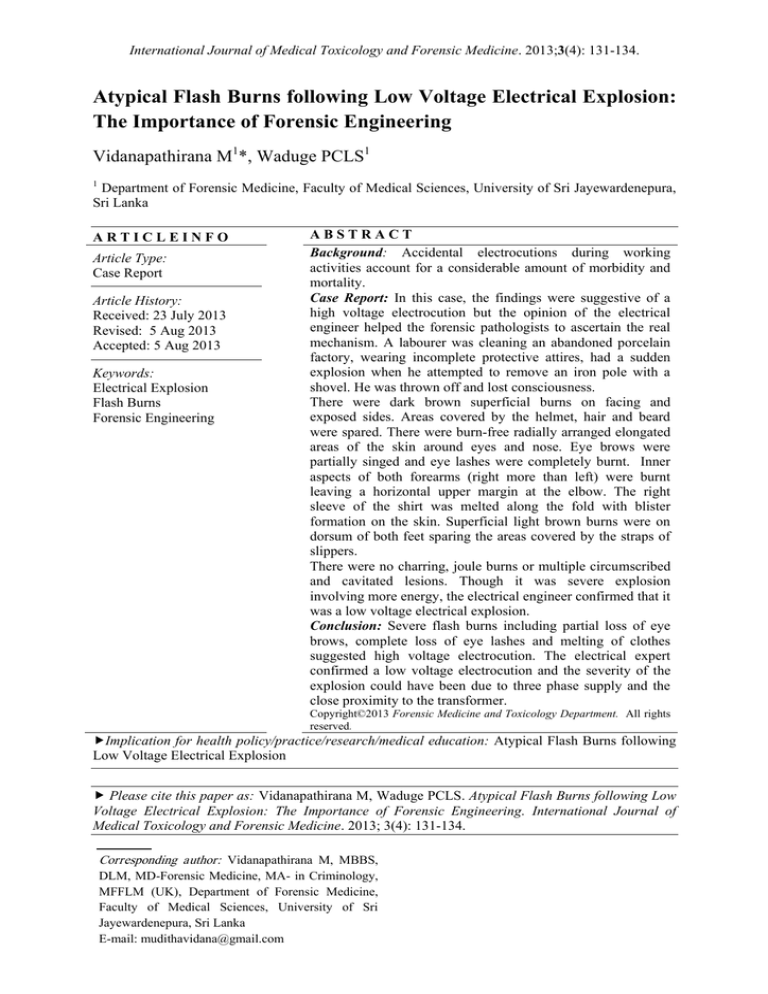
International Journal of Medical Toxicology and Forensic Medicine. 2013;3(4): 131-134.
Atypical Flash Burns following Low Voltage Electrical Explosion:
The Importance of Forensic Engineering
Vidanapathirana M1*, Waduge PCLS1
1
Department of Forensic Medicine, Faculty of Medical Sciences, University of Sri Jayewardenepura,
Sri Lanka
ARTICLEINFO
Article Type:
Case Report
Article History:
Received: 23 July 2013
Revised: 5 Aug 2013
Accepted: 5 Aug 2013
Keywords:
Electrical Explosion
Flash Burns
Forensic Engineering
ABSTRACT
Background: Accidental electrocutions during working
activities account for a considerable amount of morbidity and
mortality.
Case Report: In this case, the findings were suggestive of a
high voltage electrocution but the opinion of the electrical
engineer helped the forensic pathologists to ascertain the real
mechanism. A labourer was cleaning an abandoned porcelain
factory, wearing incomplete protective attires, had a sudden
explosion when he attempted to remove an iron pole with a
shovel. He was thrown off and lost consciousness.
There were dark brown superficial burns on facing and
exposed sides. Areas covered by the helmet, hair and beard
were spared. There were burn-free radially arranged elongated
areas of the skin around eyes and nose. Eye brows were
partially singed and eye lashes were completely burnt. Inner
aspects of both forearms (right more than left) were burnt
leaving a horizontal upper margin at the elbow. The right
sleeve of the shirt was melted along the fold with blister
formation on the skin. Superficial light brown burns were on
dorsum of both feet sparing the areas covered by the straps of
slippers.
There were no charring, joule burns or multiple circumscribed
and cavitated lesions. Though it was severe explosion
involving more energy, the electrical engineer confirmed that it
was a low voltage electrical explosion.
Conclusion: Severe flash burns including partial loss of eye
brows, complete loss of eye lashes and melting of clothes
suggested high voltage electrocution. The electrical expert
confirmed a low voltage electrocution and the severity of the
explosion could have been due to three phase supply and the
close proximity to the transformer.
Copyright©2013 Forensic Medicine and Toxicology Department. All rights
reserved.
Implication for health policy/practice/research/medical education: Atypical Flash Burns following
Low Voltage Electrical Explosion
Please cite this paper as: Vidanapathirana M, Waduge PCLS. Atypical Flash Burns following Low
Voltage Electrical Explosion: The Importance of Forensic Engineering. International Journal of
Medical Toxicology and Forensic Medicine. 2013; 3(4): 131-134.
Corresponding author: Vidanapathirana M, MBBS,
DLM, MD-Forensic Medicine, MA- in Criminology,
MFFLM (UK), Department of Forensic Medicine,
Faculty of Medical Sciences, University of Sri
Jayewardenepura, Sri Lanka
E-mail: mudithavidana@gmail.com
Vidanapathirana M et al
Atypical Flash Burns following Low Voltage Electrical Explosion …
1. Introduction:
Forensic electrical engineering is a branch
of forensic engineering. It is concerned
with investigating electrical failures and
accidents in a legal context (1).
In this case, the findings were suggestive
of a high voltage electrocution but the
opinion of the electrical engineer helped
the forensic pathologists to ascertain the
real mechanism.
2. Case Report:
A labourer was cleaning an abandoned
porcelain factory, wearing incomplete
protective attires, had a sudden explosion
when he attempted to remove an iron pole
with a shovel. He was thrown off and lost
consciousness.
There were dark brown superficial burns
on facing and exposed sides. Areas
covered by the helmet, hair and beard were
spared. There were burn-free radially
arranged elongated areas of the skin
around eyes and nose. Eye brows were
partially singed and eye lashes were
completely burnt (figure 1). He had pain in
eyes, iritis and photophobia.
Inner aspects of both forearms (right more
than left) were burnt leaving a horizontal
upper margin at the elbow (figure 2). The
right sleeve of the shirt was melted along
the fold with blister formation on the skin.
Superficial light brown burns were on
dorsum of both feet sparing the areas
covered by the straps of slippers (figure 3).
There were no joule burns or multiple
circumscribed and cavitated lesions.
Scene visit revealed a burnt electric
appliance fixed to a wall (figure 4).
Though it was a severe explosion
involving more energy, the local electrical
engineer of Electricity Board confirmed
that it was a low voltage electrical
explosion.
3. Discussion:
Accidental electrocutions during working
activities account for a considerable
amount of morbidity and mortality.
132
Fig. 1. Burn-free radially arranged elongated
areas around eyes and nose. Partially burnt
eye brows and completely burnt eye lashes.
Hair and beard were shaved at the ward and
were spared of burns.
Fig. 2. Note the burns on inner aspect of
right forearm than left and the horizontal
upper margins. Only the exposed and facing
areas were burnt.
International Journal of Medical Toxicology and Forensic Medicine. 2013;3(4)
Atypical Flash Burns following Low Voltage Electrical Explosion …
Fig. 3. Very superficial light brown burns on
dorsum of both feet sparing the areas covered
by the straps of rubber slippers.
Fig. 4. The electric appliance fixed to the wall
was severely burnt and exploded.
In low voltage electrocution, joule burn is
a classical finding at the entry wound.
Usually it is a ruptured collapsed blister
with charring at the centre, surrounded by
a pale areola and a hyperemic border (2).
Such burns were not found in this case.
There was no evidence of arcing such as
multiple, circumscribed, cavitated lesions.
The “crocodile skin” appearance2which
were found in high voltage electrocution
was also absent.
Flame burns are not limited to the exposed
and facing sides and cause charring (3)
which were not found in this case.
Radiant heat flash burns are uniform,
superficial burns found only on the facing
and exposed skin (3).
Areas covered with clothes, head hair,
beard, helmet, slippers were spared. The
sleeves of the shirt had prevented the
underlying skin being burnt and the
Vidanapathirana M et al
exposed forearms showed burns with
horizontal upper margin at elbows.
The absence of strap marks of the helmet
on the sides of the face confirmed that he
was not wearing the straps at the time of
the incident.
The radially arranged elongated spared
areas of the skin around eyes were due to
sudden tight closure of eyes.
When he was handling the shovel, the
inner aspects of the forearms facing
towards the explosion were burnt.
The presence of diffuse, brown colored
superficial burns only on facing sides of
exposed skin confirmed that the injuries
were that of flash burns due to radiant heat
of an explosion.
Blisters and the severe burns on the right
forearm could have been due to closer
proximity of the blast when handling the
shovel by this right handed person.
His face, at about twice the distance from
the source of heat, would by virtue of the
inverse square law, have received about
25% of the heat received by hands (4).
Therefore, the thermal injury to his right
hand was highest, to face was less and to
the feet were least.
Radiant heat flash burns of low voltage
electrocution usually cause only erythema
of the skin without singeing of hair (5).
Pain in his eyes and photophobia with iritis
confirmed the presence of „Flash eye‟ (4).
In flash burns, the eye lashes are singed
due to their erected posture (5).
High-tension electrocution shows the
presence of severe flash burns, multiple,
confluent areas of third-degree burns and,
more significantly, multiple circumscribed
and cavitated lesions associated with
arcing (6).
Being thrown off and lost consciousness
and the presence of severe flash burns
including eye brows, complete loss of eye
lashes and melting of clothes suggested
that those could have been due to high
voltage electrocution.
In low voltage electrocutions, the
equipment that may have been involved
should be photographed, x-rayed and
examined electrically (7).
Iinternational Journal of Medical Toxicology and Forensic Medicine. 2013;3(4)
133
Vidanapathirana M et al
Atypical Flash Burns following Low Voltage Electrical Explosion …
The electrical expert who investigated the
crime scene confirmed that it was a low
voltage electric supply and a defect in the
electrical apparatus. The high severity of
the electrical explosion was related to the
three phase supply and its close proximity
to the transformer.
References
1. Vidanapathirana M, Dahanayake KS,
Amararatne RRGS, Application of forensic
engineering, Galle Medical Journal, Vol
14:No.1, September 2009
2. Knight B, Forensic Pathology, 2nd Ed,
Arnold, London, 1996, pp.319-332
3. DiMaio VJ, DiMaio D., Fire deaths,
Forensic Pathology , 2nd Ed, CRC press,
Boca Raton, Florida, p. 367
134
4. Mason JK, Purdue BN, The pathology of
Trauma, 3rd Ed, Arnold, London, 2009, p
219.
5. Wick R, Gilbert JD, Simpson E, Byard
RW. Fatal electrocution in adults--a 30year study, S Afr Med J. 1987 Feb
7;71(3):181-2
6. DiMaio VJ, DiMaio D., Electrocution,
Forensic Pathology , 2nd Ed, CRC press,
Boca Raton, Florida, pp. 409-418
7. Sheikhazadi A, Kiani M, Ghadyani MH.
Electrocution-related mortality: a survey of
295 deaths in Tehran, Iran between 2002
and 2006. Am J Forensic Med Pathol. 2010
Mar;31(1):42-5.
International Journal of Medical Toxicology and Forensic Medicine. 2013;3(4)





